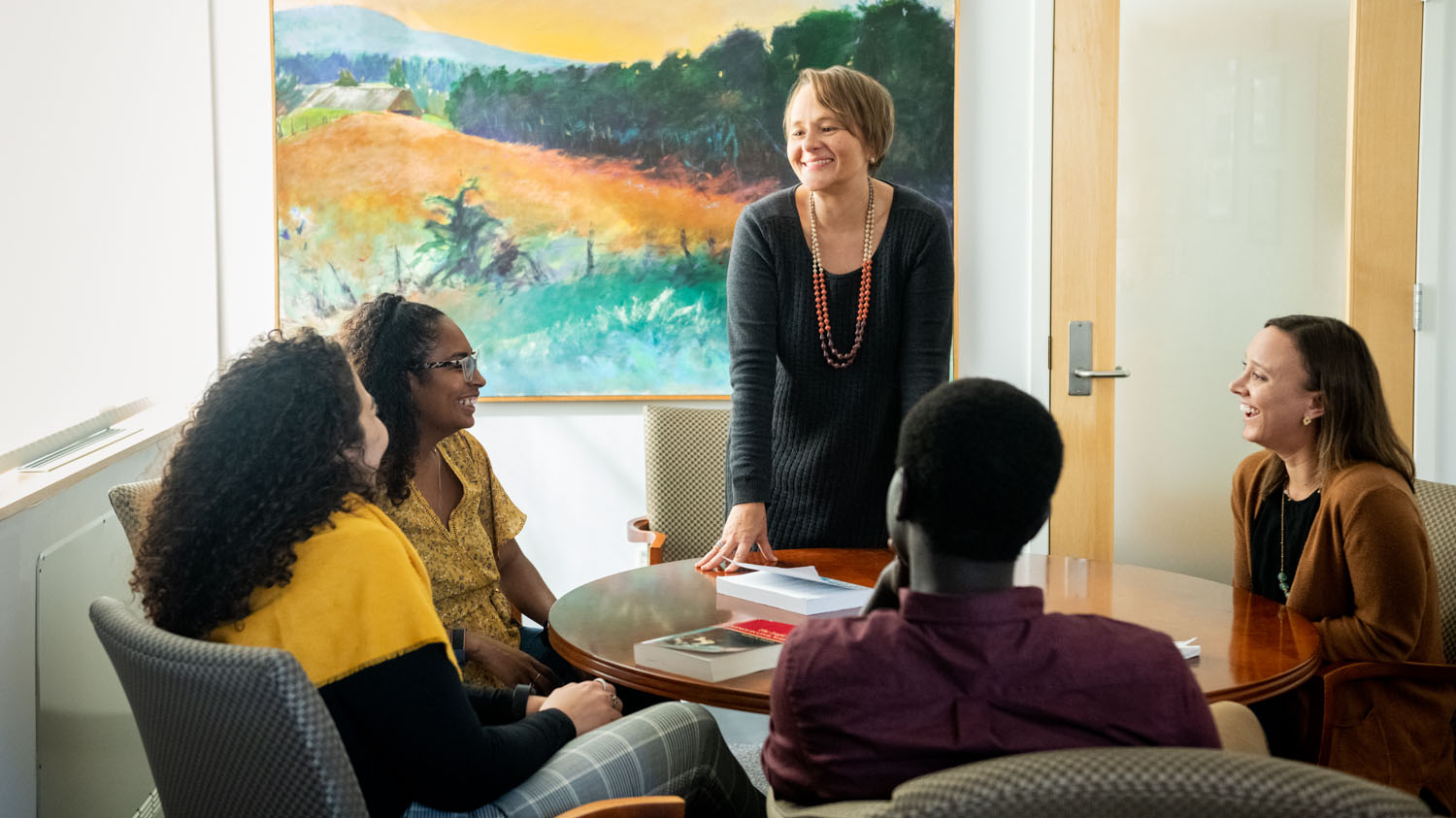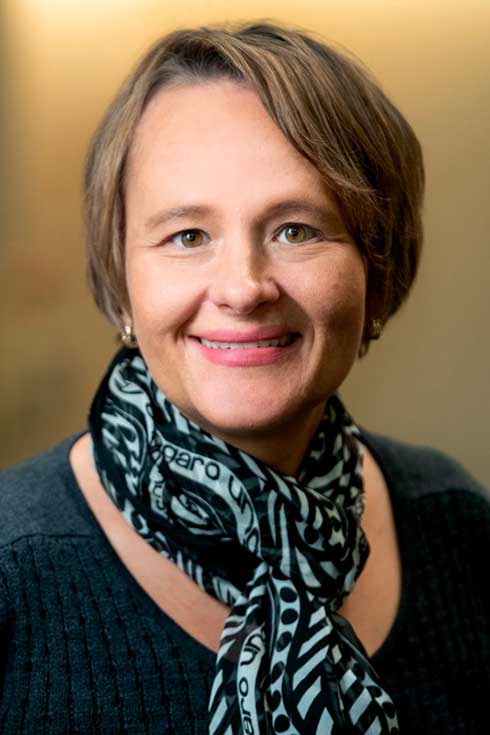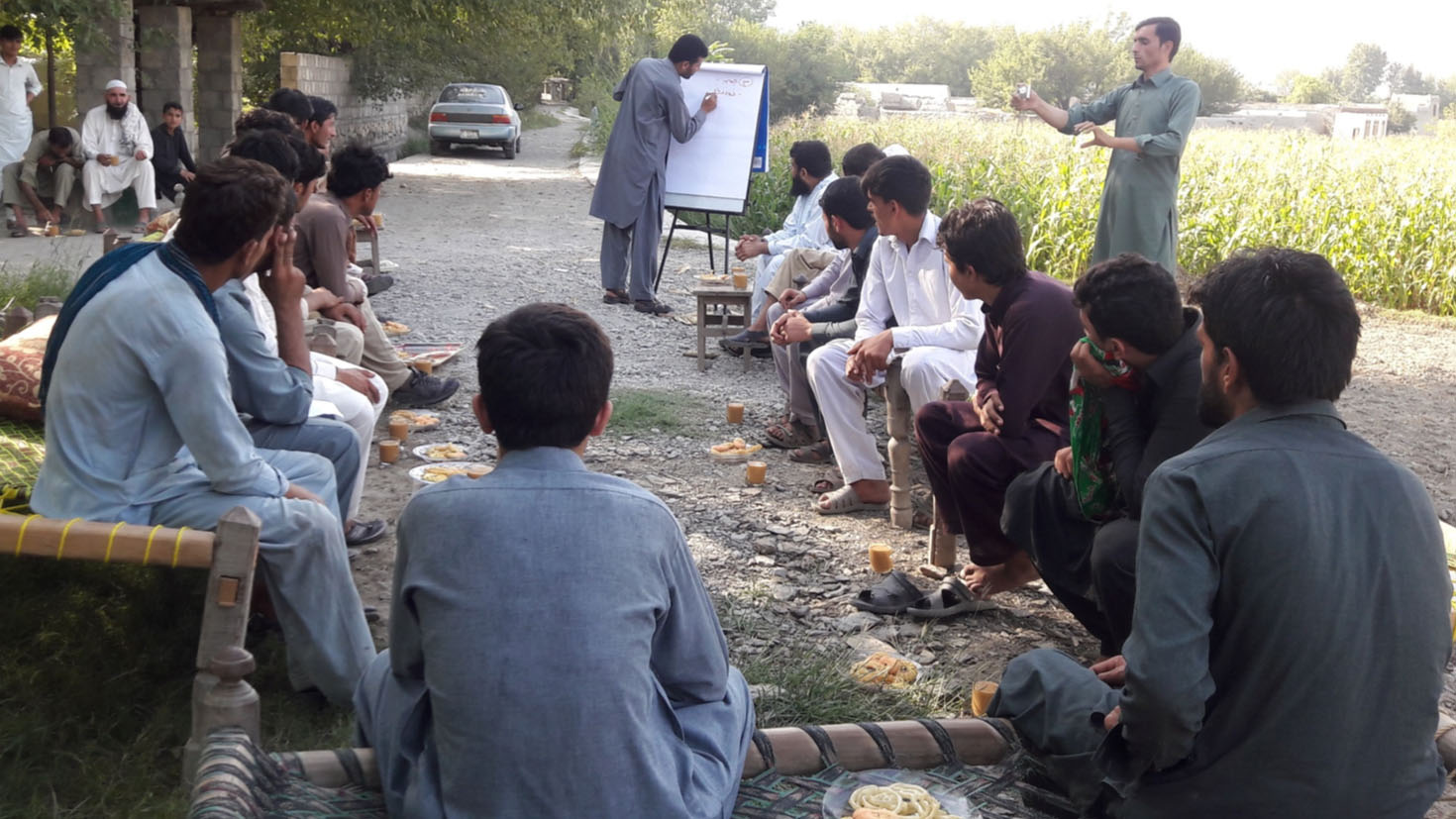
By Karen Shih
What does peace mean to you? What about reconciliation? Inclusion? Justice?
These concepts may seem too broad and nebulous to measure quantitatively. But they’re absolutely essential when it comes to healing communities around the world that have experienced conflict and instability. That’s why Associate Professor Pamina Firchow has spent the last decade developing and testing a unique methodology to capture the local understanding of these concepts as usable statistics.
“We’re translating communities’ everyday needs and everyday understanding of peace into statistics that policymakers can use to make decisions,” she says.
She’s used this methodology, called Everyday Peace Indicators (EPI), around the world, from South Sudan to Afghanistan, Sri Lanka to Colombia, working to more effectively and comprehensively represent the voices of the people.
“I was uncomfortable with the top-down approach of making policy recommendations, dictating how communities or countries should work,” Firchow says. Through EPI, “we’re looking at peacebuilding effectiveness from the bottom up, using collaborative methodologies to establish whether or not what we’re doing is actually building peace.”
Her work has been so successful that she co-founded the Everyday Peace Indicators 501(c)(3) nonprofit in 2018.
Now, she’s bringing her work to Heller. This fall, she joined the faculty of the MA in Conflict Resolution and Coexistence (COEX) program, where she’s excited to bring students into her research and develop connections with new colleagues, especially in the MA in Sustainable International Development and MS in Global Health Policy and Management programs.
“To be able to grow and become more sophisticated in my research as I’m exposed to other fields is exciting,” Firchow says.

Foundations of a Career in Peacebuilding
It was an internship with an international leader and Nobel Peace Prize winner that put Firchow on the path to a career in peacebuilding.
As an undergraduate student in political science at Carleton College, she worked one summer for Oscar Arias, the former president of Costa Rica. He was a leader of an international campaign to stop the illicit trade of small arms and light weapons, a field she would continue to engage in for the next several years.
After graduating with a bachelor’s degree, she went on to work for the campaign at the Federation of American Scientists in Washington, D.C. Then, she earned two master’s degrees: one in comparative politics from the London School of Economics, and another in international relations and peace and conflict studies from the Universidad del Salvador in Argentina, where she was a Rotary Peace Fellow.
But while she was living in Argentina, her interests shifted.
“I arrived right after the economic crisis, and I saw all the protests. Families were living in the squares. But at the same time, there was this real energy palpable in the air, an excitement for change, as these social movements were really active in the streets,” Firchow says.
She realized that a lot of the theories and methodologies for peacebuilding she’d been learning in her classes were missing a crucial component: the voice of the people.
As she pursued a doctorate from the Graduate Institute of International and Development Studies in Geneva, she started to connect the participatory action research of the international development field with her interest in conflict resolution and coexistence.
Creating the Everyday Peace Indicators

“When we talk about building peace, improving coexistence and working toward reconciliation, we need to find more ways to systematically understand what communities need,” says Firchow.
That’s why, in 2011, as a faculty member at the University of Notre Dame’s Kroc Institute for International Peace Studies, she embarked on a new project with Roger Mac Ginty, then a visiting professor from the United Kingdom.
Their goal: to have communities affected by war develop their own indicators for post-conflict success rather than having outside experts and scholars dictate them.
But the question was, how? Previous participatory research in the field had largely relied on interviews and qualitative research. It was valuable but difficult to present to policymakers, who wanted hard statistics. So Firchow and Mac Ginty developed the Everyday Peace Indicators methodology, starting with a grant from the Carnegie Corporation of New York.
Through extensive work with community members, the researchers generate a battery of indicators about a concept like peace or reconciliation. Examples include access to health facilities with doctors and supplies, or the ability to hold social events without police clearance (indicators are often very specific to a locality, referencing names and locations). Then, they use longitudinal surveys to measure how community perception of these indicators changes over time.
“The broad concept is peace, but the methodology works on any kind of difficult-to-measure social concept, whether that’s violent extremism in Afghanistan, governance and inclusion in Kenya, or coexistence and justice in Colombia,” Firchow explains.
The process starts with focus groups: men, women and youth (girls and boys). EPI-trained facilitators discuss the concepts with the groups, which is key for community buy-in. Some participants might feel as if they won a war, for example, and not understand why they might need to discuss reconciliation, while others may be still be experiencing violence and not have thought about peace in their community.
After that, they bring the focus groups together with additional community members to form a larger group that is as representative of the community as possible, and facilitators share the indicators they’ve gleaned from previous discussions.
“For many people, that’s the ‘aha’ moment,” Firchow says. “They finally see what we’re doing. That’s the key moment, because that’s when they start to add or take out indicators.”
Finally, the broader community is invited to a final meeting, where all vote for their top indicators. That final list is developed into a survey for the entire community. Once the data is collected, the researchers code it and can make recommendations to community-based partners, village by village.
“Though it’s intensive, both in terms of time and resources, it results in this rich data,” Firchow says. “The strength of this project is in the details, because you can always generalize later on, but you cannot recreate the detailed information about how these community members are living their everyday lives.”
A "Mini-Ethnography"

Satellite dishes on rooftops in Afghanistan. Drinks left on a table at a bar in Rwanda. Muslim children taking part in New Year’s games in Sri Lanka.
None of these might jump immediately to mind as indicators of peace. But these were just a few of the indicators Firchow and her team have gleaned through the EPI methodology while working around the world.
“The everyday indicators are like a mini-ethnography. They serve as a window into the communities,” Firchow says.
In Afghanistan, for example, the presence of many satellite dishes indicates less violent extremism, because those extremist actors tend to prohibit radio, television and any outside media. In Rwanda, the threat of poison after the genocide meant people at a bar might take their drinks with them when they went to the bathroom — but drinks left on a table signified there was more trust. In Sri Lanka, which has struggled with religious and ethnic conflict, the ability of Muslim children to join the fun on New Year’s Day means the community has, to some extent, worked out some of those differences.
“One of the things that I thought was really interesting was that you could see the diverse issues that emerged out of seemingly similar communities,” Firchow remarks.
For example, Firchow is currently working on a United States Agency for International Development project in Sri Lanka, where she and her colleagues are embedded in its reconciliation programming, focused on repairing relations after the civil war that raged for a quarter of a century.
“Out of our set of 30 villages, one community clearly had a problem with sexual violence. These types of indicators didn’t emerge in any other place. They were very specific, and immediately I could say, ‘Look, this is a salient issue here and you need to address it.’ It’s not just one informant — the whole community feels it’s important,” she explains.
In other projects, all villages across a region may converge on certain unexpected indicators, such as in Afghanistan.
“In every single community, whether it was Taliban-controlled or not, one of the top-five indicators of peace was girls going to school,” Firchow says. “That doesn’t fit with any of our assumptions about rural Afghanistan.”
She published her findings on this topic in the journal Foreign Policy earlier this year, arguing that it’s important to listen to these local voices and to redirect investment toward girls’ education and women’s professional development, given the broad support.
Convivencia in Colombia

Today, Firchow’s major focus is Colombia, which was plagued by conflict for nearly half a century until peace accords between the Revolutionary Armed Forces of Colombia, or FARC guerrilla movement, and the Colombian government were ratified in 2016.
“Our goal is to understand the local notions of justice and convivencia, a Spanish term between coexistence and reconciliation,” she says.
Firchow is working with Peter Dixon, a recently appointed research scientist at Heller, on a project funded by the National Science Foundation, the United States Institute of Peace (USIP) and Humanity United. They started in the Antioquia region, which was heavily affected by the conflict, and will extend to two other conflict-affected areas. Currently, they are focusing on one municipality, Dabeiba, where various post-accord actors are engaged in its villages, including work on development projects, collective reparations and farc demobilization. The other municipality they chose in Antioquia was Urrao, which has no such actors. They’re comparing the two to evaluate the effectiveness of the different post-accord mechanisms, and are currently collecting indicators. They hope to inform the Colombian Truth Commission and the Special Jurisdiction for Peace about how these post-accord mechanisms are being received by locals.
Next spring, thanks to a Fulbright Fellowship, Firchow will be on the ground in Colombia, where she will also be working on two other Carnegie Corporation-funded projects. One is piloting the possibility of creating a bottom-up barometer for indigenous groups and is being tested with the Pasto indigenous people in Nariño and Putumayo. Another focuses on data flows in peace processes, which serves as the basis of her next book with Mac Ginty, “Inclusive Measurement: Information Flows and Decision-Making in Peace Processes.” This follows her first book, “Reclaiming Everyday Peace: Local Voices in Measurement and Evaluation After War,” published last year by Cambridge University Press, which discusses EPI methodology and presents local peacebuilding effectiveness findings using case studies in Colombia and Uganda.
“If you look at communities in war-torn societies in the post-conflict period, surprisingly and perplexingly, the interventions are mostly not peacebuilding interventions, such as relationship building and rebuilding the social network and fabric of the community,” she says. “Instead, they’re focused on development, security. In the book, I argue that it’s clear what’s needed is more societal relationship building and more funding for these kinds of peacebuilding interventions.”
New Opportunities at Heller
This fall, after five years at George Mason University’s School for Conflict Analysis and Resolution, including a year as a Jennings Randolph Senior Fellow at USIP, Firchow started at Heller as an associate professor in the COEX program.
“The students are enormously dedicated and engaged. I was thinking, during orientation, that it kind of feels like a family, and that’s wonderful, especially when you are dealing with such difficult issues and topics in peace and conflict studies,” she says. “A master’s program like this can retraumatize, so having those networks and ability to depend on one another is enormously important.”
Firchow is eager to bring students into her work, as well as tap her network for guest speakers to invite into her classes.
Though she’s just a semester into her tenure, she’s seen the overlaps between her work and the research of her colleagues in other fields, and she’s eager to learn from them as she expands EPI's scope and projects.
“I’m happy to be part of the COEX program,” Firchow says, as a faculty member of a graduate school that also houses master’s programs in international development and global health. “These really are the cornerstones of peacebuilding, and it creates a trifecta that’s unique. Being able to exchange ideas between programs, learn from one another, that’s really exciting.”
